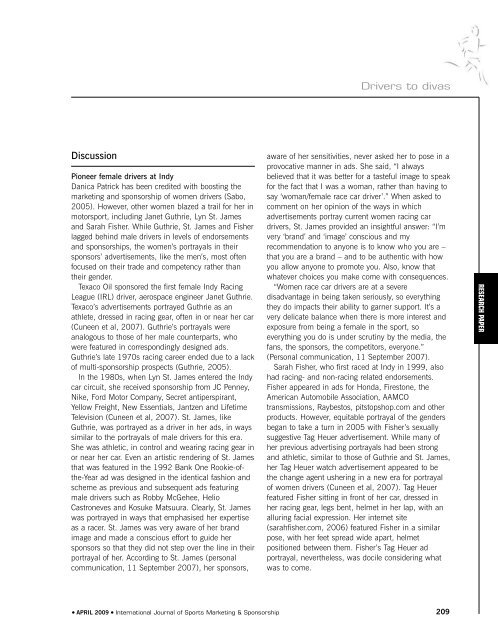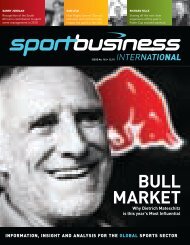Sports Marketing & Sponsorship - FIFA/CIES International University ...
Sports Marketing & Sponsorship - FIFA/CIES International University ...
Sports Marketing & Sponsorship - FIFA/CIES International University ...
- No tags were found...
You also want an ePaper? Increase the reach of your titles
YUMPU automatically turns print PDFs into web optimized ePapers that Google loves.
Drivers to divasDiscussionPioneer female drivers at IndyDanica Patrick has been credited with boosting themarketing and sponsorship of women drivers (Sabo,2005). However, other women blazed a trail for her inmotorsport, including Janet Guthrie, Lyn St. Jamesand Sarah Fisher. While Guthrie, St. James and Fisherlagged behind male drivers in levels of endorsementsand sponsorships, the women’s portrayals in theirsponsors’ advertisements, like the men’s, most oftenfocused on their trade and competency rather thantheir gender.Texaco Oil sponsored the first female Indy RacingLeague (IRL) driver, aerospace engineer Janet Guthrie.Texaco’s advertisements portrayed Guthrie as anathlete, dressed in racing gear, often in or near her car(Cuneen et al, 2007). Guthrie’s portrayals wereanalogous to those of her male counterparts, whowere featured in correspondingly designed ads.Guthrie’s late 1970s racing career ended due to a lackof multi-sponsorship prospects (Guthrie, 2005).In the 1980s, when Lyn St. James entered the Indycar circuit, she received sponsorship from JC Penney,Nike, Ford Motor Company, Secret antiperspirant,Yellow Freight, New Essentials, Jantzen and LifetimeTelevision (Cuneen et al, 2007). St. James, likeGuthrie, was portrayed as a driver in her ads, in wayssimilar to the portrayals of male drivers for this era.She was athletic, in control and wearing racing gear inor near her car. Even an artistic rendering of St. Jamesthat was featured in the 1992 Bank One Rookie-ofthe-Yearad was designed in the identical fashion andscheme as previous and subsequent ads featuringmale drivers such as Robby McGehee, HelioCastroneves and Kosuke Matsuura. Clearly, St. Jameswas portrayed in ways that emphasised her expertiseas a racer. St. James was very aware of her brandimage and made a conscious effort to guide hersponsors so that they did not step over the line in theirportrayal of her. According to St. James (personalcommunication, 11 September 2007), her sponsors,aware of her sensitivities, never asked her to pose in aprovocative manner in ads. She said, “I alwaysbelieved that it was better for a tasteful image to speakfor the fact that I was a woman, rather than having tosay ‘woman/female race car driver’.” When asked tocomment on her opinion of the ways in whichadvertisements portray current women racing cardrivers, St. James provided an insightful answer: “I’mvery ‘brand’ and ‘image’ conscious and myrecommendation to anyone is to know who you are –that you are a brand – and to be authentic with howyou allow anyone to promote you. Also, know thatwhatever choices you make come with consequences.“Women race car drivers are at a severedisadvantage in being taken seriously, so everythingthey do impacts their ability to garner support. It’s avery delicate balance when there is more interest andexposure from being a female in the sport, soeverything you do is under scrutiny by the media, thefans, the sponsors, the competitors, everyone.”(Personal communication, 11 September 2007).Sarah Fisher, who first raced at Indy in 1999, alsohad racing- and non-racing related endorsements.Fisher appeared in ads for Honda, Firestone, theAmerican Automobile Association, AAMCOtransmissions, Raybestos, pitstopshop.com and otherproducts. However, equitable portrayal of the gendersbegan to take a turn in 2005 with Fisher’s sexuallysuggestive Tag Heuer advertisement. While many ofher previous advertising portrayals had been strongand athletic, similar to those of Guthrie and St. James,her Tag Heuer watch advertisement appeared to bethe change agent ushering in a new era for portrayalof women drivers (Cuneen et al, 2007). Tag Heuerfeatured Fisher sitting in front of her car, dressed inher racing gear, legs bent, helmet in her lap, with analluring facial expression. Her internet site(sarahfisher.com, 2006) featured Fisher in a similarpose, with her feet spread wide apart, helmetpositioned between them. Fisher’s Tag Heuer adportrayal, nevertheless, was docile considering whatwas to come.RESEARCH PAPER● APRIL 2009 ● <strong>International</strong> Journal of <strong>Sports</strong> <strong>Marketing</strong> & <strong>Sponsorship</strong>209
















